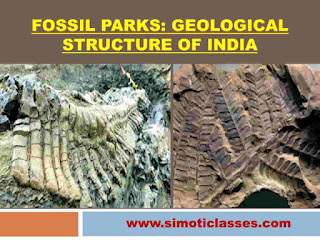Fossil Parks
Fossil Parks are important as they provide information about the diversity and the evolution of life through time. They help in preserving the fossils and spread awareness to the public about the values of fossils. The protected areas are maintained by the Geological Survey of India, to preserve the rocks, minerals, fossils, and meteorites.
1. Shivalik Fossil Park (Saketi, Sirmaur district, Himachal Pradesh):
- It has size models of vertebrates that might have inhabited Shivalik Hills, about 1.5 to 2.5 million years ago.
- It covers an area of about 1.5 km2 in the Markanda valley of Sirmaur. This park was built to put a check on the destruction of fossil bones. This site has been developed to a panorama of the Pilo-Pleistocene period (2.5 million years) through large afforestation.
2. Mandla Plant Fossils National Parks (Dindori, Madhya Pradesh):
- This national park preserves the fossil remains of primordial forest about 40-150 million years ago.
- The total area of the park is o.25 km2 which is spread over seven (7) villages of Dindori district namely- Ghuguwa, Umaria, Deorakhurd, Barbaspur, Chanti Hills, Chargaon, and Deori Kohani.
3. Ghughua Fossil Parks (Madhya Pradesh):
- The national park has a trove of plant fossils belonging to 31 genera of 18 plant families.
- The fossils indicate life in the area about 65 million years ago.
4. Marine Gondwana Fossil Park, Manendragarh, Sarguja district, Chattisgarh
- It has fossiliferous marine Permian rocks of Talchir formation dated 280-240 million years.
- It has a spread of 1 km on the right bank of the Hasdeo river and Hashia Nala.
5. National Fossil Wood Park, Tiruvakkarai, Tamil Nadu
- It has 200 fossil trees ranging in length from 3-15 m and up to 5 m in girth which are seen as lying horizontally embedded in the Cuddalore Sandstone of the Mio-Pliocene age about 20 million years ago.
- It covers an area of 1 Km2.
- The longest specimen measures 13.4 m X 0.9 m.
- Scientists believe that these trees did not grow at that site but were transported there before they were permitted.
6. National Fossil Wood Park, Santhanur, Tamil Nadu
- This wood park contains large trunks of petrified trees (conifers) of the Upper Cretaceous age (100 million years ago).
- The fossilized tree trunk at Sathanaur measures over 18 m in length.
7. Akal Wood Fossil Park, Jaisalmer district, Rajasthan
- The fossil of the wood found in this park reflects the warm and humid climate considering the sea some 180 million years ago.
- It contains fossils of wooden logs (petrophyllum, ptyllophyllum, equisetitis species, and dicotyledonous wood and gastropod shells of the Lower Jurassic period) lying in random horizontal orientation.
8. Stromatolite Park, Bhojunda, Chittaurgarh, Rajasthan
- Stromatolites are structures produced by blue-green algae.
- They are the result of the combination of life activity and sediment trapping ability of algae and the preying bacteria.
- Their formation occurs in shallow water where the tides bring the floating sedimentary material and make it flow through carbonate particles. These are the impressions of the earliest life forms.
9. Stromatolite Park, Jharkhand, and Udaipur district, Rajasthan
- It is the largest and rich in deposits of phosphorite.
- This site preserves and provides shreds of evidence of early life on the earth.
- The rocks phosphate occurs in dolomite limestone associated with stromatolites which have a bluish-grey appearance.
|
State |
|
Rajasthan |
|
Chattisgarh |
|
Karnataka |
|
Himachal Pradesh |
Siwalik Fossil Park, Saketi, Sirmaur. |
Jharkhand |
|


















0 comments:
Post a Comment